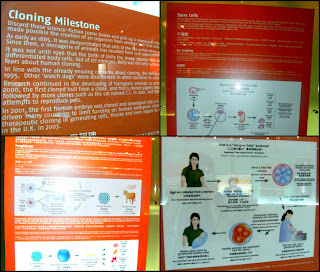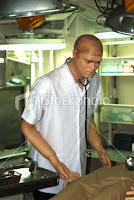
The lack of interactive elements requires visitors to engage in self-learning as they peruse the wordy panels about cloning. As such, because of the rather uninspiring exhibit, we have provided a few suggestions to make it more interactive and thus stimulating critical public engagement of science.
Before that, let’s explore the degree of public engagement on cloning.
Critical public engagement with science can be seen in the case of United Kingdom’s (UK) 'Sciencehorizons', a government initiated public discussion forum on various issues pertaining to science. Singapore's similar scientific institutions of the Science Centre and A*Star do not promote much scientific discussion with the public. This could perhaps be due to the state’s assumption that the general public is apathetic and ignorant on issues such as human embryo cloning.
The government’s stance on the legitimization of the human embryo cloning in Singapore is the purview of the Bioethics Advisory Committee (BAC). The BAC consults religious, scientific and healthcare representatives for feedback, in addition to gathering responses from the general public and interest groups through its website. However, how many are aware of such existing participatory platforms?
Attempts at public engagement are simply a pretense of inclusiveness if they don’t influence decision making, which we feel is the case in Singapore as BAC seems to have a predisposition to safeguard their own interests. Therefore, the local’s public voice, in contrast to UK, seems to be suppressed.
From the pictures above, the cloning exhibitions in Science Centre are informative and multi-lingual (i.e. English, Chinese, Malay and Japanese) to cater to the wide span of visitors. The writing style is comprehensive and although we do see the use of some scientific jargon (i.e. nucleus or embryo), they do not make cloning harder to understand but instead aid in educating and equipping the public with the necessary vocabulary. Moreover, these words are usually explained in the DNA exhibits preceding the Cloning section. Hence, visitors would have had a brief encounter and insight of them.
In addition, interactive multimedia games (featured right) allow visitors to take on the role of a scientist and engage in either reproductive or therapeutic cloning. The cloning sequence and processes are then demonstrated simply and clearly.
However, while these panels are certainly informative, it tends to be dull and comparatively unattractive especially when juxtaposed with the visually appealing DNA exhibits. One of our group mates had a hard time locating it because the exhibit was rather inconspicuous. It did not have any hands-on activities other than two monitor screens for virtual games.
The proposed exhibit will feature a realistic laboratory mock-up, with various equipments (PCR machine, test-tubes, centrifuges, micro-pipette, etc.) used in contemporary bio-science laboratories. Figurines/mannequins of lab-technicians could be added for effect depending on available space.
 We propose that this new installation should have an overlay of interactive media elements to create an engaging and enriching experience.
We propose that this new installation should have an overlay of interactive media elements to create an engaging and enriching experience. Augmented reality applications can be applied for educational and entertainment purposes. Visual overlays on the static set-up could be attained using camera equipped mobile devices (Apple’s iPhone would be ideal)